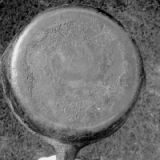Cast Iron Restoration
 You've probably looked at an old cast iron skillet at a garage sale or flea market, and thought, "That might be a pretty nice pan; too bad it's rusty or so coated in crud. Cleaning it would not be worth the trouble, if it's even possible." Truth is, it's much easier than you might think to clean and restore that old pan to almost like-new.
You've probably looked at an old cast iron skillet at a garage sale or flea market, and thought, "That might be a pretty nice pan; too bad it's rusty or so coated in crud. Cleaning it would not be worth the trouble, if it's even possible." Truth is, it's much easier than you might think to clean and restore that old pan to almost like-new.
Surface-only rust is dusty and lighter orange in color than rust that has begun to cause damage, which will be flaky and a darker shade of reddish-brown. If it has not progressed to the point of eroding and pitting metal, light rust can be removed easily, leaving the iron fairly intact in appearance.
"Crud" can be thought of as a generic term for any cooking build-up on a pan you didn't put there yourself. Your own is "seasoning"; other people's is crud.
Or maybe the difference between the two is seasoning is what's left behind after cooking and washing, and crud is what's on those pans that look like they were never taken off the stove burner.
Crud can be good, though, for it shields those old pans that have been laying around in the basement or out in a barn for years against rust to a good degree. But make no mistake, that crud is not something to be preserved.
Sure, you want to get rid of rust and crud, but what about a piece that has that nice shiny black patina? That old patina might look great, but if you think you ever want to cook in a piece of vintage cast iron cookware you've acquired from somewhere, you have to consider that you don't know what's been done to it previously, no matter how good it looks. If you cannot be absolutely certain the pan was not exposed something dangerous or even unpleasant (think insecticide or mouse pee), stripping the piece and starting over is both wiser and safer.
Sometimes, you'll encounter pieces for sale which the seller has already stripped and applied a coat of seasoning themselves. Usually, it's been done in a hurry, using too much oil in one pass, with the result being a sticky mess. You'll do better starting over with these pieces as well.
The most often-used methods for collector-approved, non-destructive cast iron cleaning utilize a lye bath and/or an electrolysis setup. Both are fairly easy to implement and work well, but do require the acquisition and assembly of some supplies and equipment, as well as the observation of some basic safety protocols.
But you may also be quite successful using just a few commonly available household items, which we'll cover as well.









